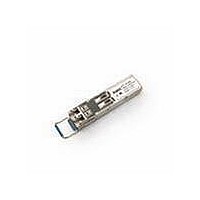AFCT-5760TPZ Avago Technologies US Inc., AFCT-5760TPZ Datasheet - Page 4

AFCT-5760TPZ
Manufacturer Part Number
AFCT-5760TPZ
Description
TXRX SFF SM OC3/STM-1 BAIL IR
Manufacturer
Avago Technologies US Inc.
Series
METRAKr
Datasheet
1.AFCT-5760LZ.pdf
(20 pages)
Specifications of AFCT-5760TPZ
Data Rate
155Mbps
Wavelength
1300nm
Applications
General Purpose
Voltage - Supply
3.1 V ~ 3.5 V
Connector Type
LC Duplex
Mounting Type
SFP
Function
SMF Transceiver, Streamlined for those applications where DMI features are not needed.
Product
Transceiver
Maximum Rise Time
2.5 ns
Maximum Fall Time
2.5 ns
Operating Supply Voltage
3.1 V to 3.5 V
Maximum Operating Temperature
+ 85 C
Minimum Operating Temperature
- 10 C
Package / Case
SFP
Lead Free Status / RoHS Status
Lead free / RoHS Compliant
Lead Free Status / RoHS Status
Lead free / RoHS Compliant, Lead free / RoHS Compliant
Receiver Section
The receiver section for the AFCT-576xZ contains an
InGaAs/InP photo detector and a preamplifier mounted
in an optical subassembly. This optical subassembly is
coupled to a post amplifier/decision circuit on a circuit
board. The design of the optical subassembly provides
better than 12 dB Optical Return Loss (ORL).
Connection to the receiver is provided via a LC optical
connector.
RX_LOS
The receiver section contains a loss of signal (RX_LOS)
circuit to indicate when the optical input signal power
is insufficient for SONET/SDH compliance. A high signal
indicates loss of modulated signal, indicating link failure
such as a broken fiber or a failed transmitter. RX_LOS can
be also be monitored via the two-wire serial (address A2,
byte 110, bit 1).
Functional Data I/O
Avago’s AFCT-576xZ transceiver is designed to accept
industry standard differential signals. The transceiver pro-
vides an AC-coupled, internally terminated data interface.
Bias resistors and coupling capacitors have been included
within the module to reduce the number of components
required on the customer’s board. Figure 2 illustrates the
recommended interface circuit.
Digital Diagnostic Interface and Serial Identification
The AFCT-576xZ family complies with the SFF-8074i spec-
ification, which defines the module’s serial identification
protocol to use the 2-wire serial CMOS EEPROM protocol
of the ATMEL AT24C01A or similar. Standard SFP EEPROM
bytes 0-255 are addressed per SFF-8074i at memory ad-
dress 0xA0 (A0h).
As an enhancement to the conventional SFP interface
defined in SFF-8074i, the AFCT-5765Z is also compliant
to SFF-8472 (the digital diagnostic interface for SFP). This
enhancement adds digital diagnostic monitoring to stan-
dard SFP functionality, enabling failure prediction, fault
isolation, and component monitoring capabilities.
Figure 3. MSA required power supply filter
4
SFP MODULE
V
V
CC
CC
T
R
0.1 µF
0.1 µF
HOST BOARD
10 µF
1 µH
1 µH
0.1 µF
10 µF
3.3 V
Using the 2-wire serial interface, the AFCT-5765Z pro-
vides real time access to transceiver internal supply volt-
age and temperature, transmitter output power, laser
bias current and receiver average input power, allowing
a host to predict system compliance issues. These five
parameters are internally calibrated, per the MSA. New
digital diagnostic information is accessed per SFF-8472
using EEPROM bytes 0-255 at memory address 0xA2
(A2h).
The digital diagnostic interface also adds the ability to
disable the transmitter (TX_DISABLE), monitor for Trans-
mitter Faults (TX_FAULT) and monitor for Receiver Loss
of Signal (RX_LOS).
Contents of the MSA-compliant serial ID memory are
shown in Tables 3 to 7. The SFF-8074i and SFF-8472
specifications are available from the SFF Committee at
http://www.sffcommittee.org.
Predictive Failure Identification
The diagnostic information allows the host system to
identify potential link problems. Once identified, a fail-
over technique can be used to isolate and replace sus-
pect devices before system uptime is impacted.
Compliance Prediction
The real-time diagnostic parameters can be monitored
to alert the system when operating limits are exceeded
and compliance cannot be ensured.
Fault Isolation
The diagnostic information can allow the host to pin-
point the location of a link problem and accelerate sys-
tem servicing and minimize downtime.
Component Monitoring
As part of the host system monitoring, the real time di-
agnostic information can be combined with system level
monitoring to ensure system reliability.
Application Support
An Evaluation Kit and Reference Designs are available to
assist in evaluation of the AFCT-576xZ SFPs. Please con-
tact your local Field Sales representative for availability
and ordering details.



















